Order-Lithuanian relations year 1365
From the end of the 13th to the beginning of the 15th century, the Teutonic Order carried out military campaigns into the territory of pagan Lithuania. "In the year of our Lord 1283 ... the brothers of the Teutonic House began a war with that people, powerful and stubborn and seasoned in battle, who were closest to the land of Prussia and lived beyond the Memel River in the land of Lithuania" (SRP 1, 146). The campaigns consisted of devastating raids on Lithuanian lands, sieges of fortifications, and the capture of prisoners and booty. At the beginning of the 14th century, the arrival of knights-guests in the Prussian Order began, and the Order's military campaigns, or "raises", associated with them began, which continued throughout the century. "In the year of our Lord 1304, pilgrims from Alemannia, at the inspiration of the Lord, began to visit the land of Prussia again" (SRP 1, 170). In turn, Lithuania and Samogitia, which bordered the Order’s Prussia, “did not remain in debt” – almost every year, no less devastating raids were carried out on Prussia.
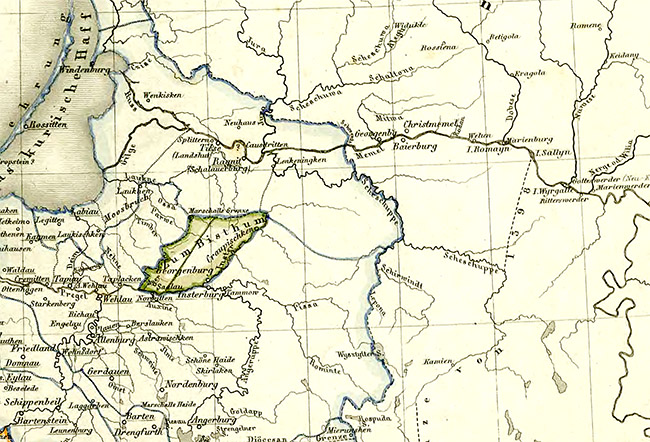
The year 1365 AD was no exception in this regard. The year began with a raid by Prince Trok and the ruler of Samogitia, Kestutis. Having passed through the forests of the Pustosh, Kestutis and his army reached the castle of Angerburg (Węgorzewo), in which at that time there was neither a pfleger nor his kumpan, but only eight people left for guard, occupied and destroyed the castle (SRP 2, 548).
As part of the "counter-move", an army was assembled under the command of the commander of Ragnit (Niemen) Bukhard von Mansfeld and the bailiff of Samland Rüdiger von Elner the Younger. The army that went to the rise also included the English guest Thomas de Beauchamp, 11th Earl of Warwick with his son William, who had just arrived in Prussia. Probably, Robert de Namur, Marshal of Brabant, son of the Count of Namur, who had been in Prussia since the previous year, also took part in the campaign. The army entered the lands of Ergolen (now the area of the settlement of Ariogala) and Pastoven (not identified, presumably the area of Pastov, 20 km northwest of Kaunas). The lands were devastated, settlements were destroyed, and three days later the army returned with great spoils (SRP 2, 548-9).
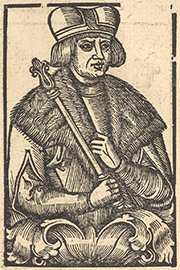
In the second half of February, in the period from St. Valentine's Day to Meatfare (from February 14 to 25), the united forces of the Lithuanian princes again invaded the border lands of the Order, in the region of Shalavy. At the head of the army were the brothers Keistut and Olgerd, as well as Keistut's son Patrikei, the prince of Grodno, and Alexander Koriatovich, the nephew of Keistut and Olgerd, the prince of Podolsk. Three armies of four thousand men captured and destroyed the castles of Kaustritten and Shplitter (fortifications in the area of today's Sovetsk) and the castle of Shalauerburg (in the area of the city of Neman). Having taken prisoners, the troops went to the Curonian Lagoon, where they captured fourteen fishermen, as well as the horses of the commander Ragnit. There, on the shore of the lagoon, the Lithuanians sacrificed a bull and one prisoner, an Order brother named Hansel Neuwenstein, to the gods. The fourth army, led by one of the brothers, was engaged in the devastation of the Skalov lands, where 800 people were taken prisoner (SRP 2, 85, 548-9; 3, 83-4).
In 1365, Prince Dorogichinsky Butovt led a conspiracy of Lithuanian boyars against his father Keistutis. Butovt entered into negotiations with the Order and declared his readiness to accept Catholic baptism and form an alliance against the Lithuanian princes. The Vilnius governor, boyar Dirsun, a supporter of Keistut, arrested Butovt and imprisoned him in one of the border fortresses. Boyar Survill, a supporter of Butovt, who served as a mediator in the negotiations with the Order, captured the fortress and freed the captive prince. Boyar Dirsun was killed by the conspirators, and Butovt and his comrades hid in the territory of the Order's Prussia (Antonovich, 1878).
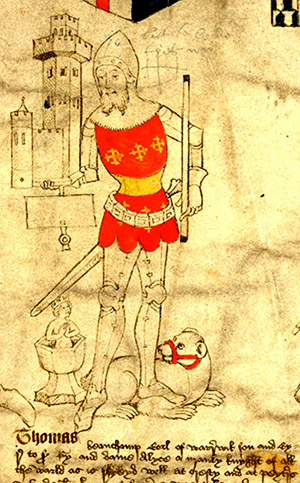
"In the same year, around the feast of St. James," Butovt and fifteen companions arrived at Insterburg Castle, where they were received by Pfleger Heinrich von Schöningen, who escorted them to Marienburg to the Grand Master. By decision of Master Winrich von Kniprode and the great administrators, Butovt and his companions were to be baptized in Königsberg, where the English guests were staying at the time. On July 25, in the presence of a large gathering of guests, including, in addition to the brothers of the order, Bishops John of Warmia, Bartholomew von Radam of Samland, and priests, as well as the English guests, Sir Thomas de Beauchamp, Earl of Warwick, and Sir Thomas de Ufford, Knight of the Order of the Garter, the baptism of the defectors took place. At his baptism, Butovt received the name Heinrich (SRP 2, 550; 3, 84). It is unknown who became his godfather, but there is some indirect information about the godfather of one of his companions, the boyar Surville, who received the name Thomas. According to the English chronicles "Rous Roll" and "Beauchamp Pageants", created in the 1480s, "Thomas Beauchamp ... also fought in the heathen country for three years and brought home the son of the King of Lithuania, baptized him in London and called Thomas in his honor" (BL Add. Ms. 48976, f.6ar). The image on the scroll, in addition to the Earl of Warwick, also shows the "son of the King of Lithuania" sitting in the baptismal font. These descriptions are distorted echoes of the events of the baptism of Butovt and Surville. Soon after his baptism, Butovt left Prussia and was received in Prague at the court of Emperor Charles IV, from whom he received the ducal title and an endowment. Surville remained in the service of the order and is mentioned in order documents until the end of the 14th century (GStA PK, XX. HA, Urkunden Schieblade XXVII Nr. 223), including as a pfleger of Rastenburg. The coat of arms of Thomas Surville and his brother Hans are even found in the Bellenville armorial on the seventh scroll, with the depiction of the coats of arms of the participants of the rise of 1380-81 (L'armorial Bellenville, fol. 62v-63r).
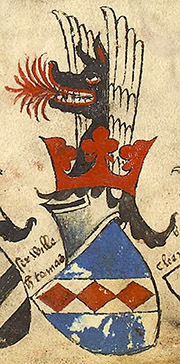
At the beginning of August, the commander of Goldingen (Livonia), Siegfried von Lahnstein, with the Courlanders, went on a campaign against Lithuania, in which he killed 400 Lithuanians, losing one knight and 14 warriors (SRP 2, 85).
In August, the Order's army, led by Master Winrich von Kniprode and the newly baptized Butovt-Heinrich, set out on a campaign against the Vilnius castle. Everyone was told to take with them provisions for at least a month. On the day of the Assumption of the Virgin Mary (August 15), the army forded the Viliya River, and Master Sanders, the chamberlain, drowned. Over the course of two days, the army ravaged the lands of Popparter (the Poporce region on the left bank of the Viliya River, 40 km northwest of Vilnius) and Slavegen (the region between Eigule on the Viliya River and Rumšički on the Neman River).
Then the troops marched with fire and sword through the lands of Gaizov (Gaizhuvela district, 30 km north of Kaunas), Labuno (Labunava district, left bank of the Nevėžys River, 30 km north of Kaunas), Simen (Žeimiai district, between the Nevėžys and Viliya Rivers, 40 km north-east of Kaunas), Svintoppenses (Šventupė district, 70 km north-east of Kaunas), Mirgenses (Ukmergė/Vilkomir district) and reached the Vilnius Castle. They failed to capture the castle itself and the troops ravaged its surroundings. Then the troops moved through Labuno and reached Nergi (Viliya River).
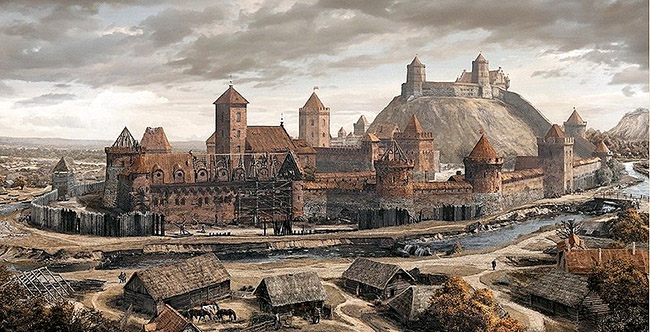
The troops then apparently split up - separately from the master and Supreme Marshal Hennig Schindekopf, the commander of Elbing, Ortulf von Trier, and Werner von Rundorf, the commander of Christburg, acted. The Vogt of Samland with the bishop's men occupied the abandoned castles of Masgallen (Maišiagala, 25 km northwest of Vilnius) and Kernov (Kernavė, 35 km northeast of Vilnius), the territory around was devastated by the army, and the castles were destroyed.
On the seventh day, the Order's troops defeated a Lithuanian detachment of 500 men on the river bank. In the following days, the troops marched back through scorched and devastated lands and on the tenth day they reached the land of Sloassen (not established, presumably Slavegen). They crossed the Viliya River in boats and headed home. Christians and Lithuanians were rescued from captivity. The entire rise took about two weeks (SRP 2, 85, 550-3; 3, 84).
In the same year, the Landmaster of Livonia, Wilhelm von Friemersheim, twice went on a campaign “into Lithuania for six days and devastated everything with plunder and fire” (SRP 2, 85). Presumably both times in the land of Opiten (the Opiten region, 12 km south of Panevezys).
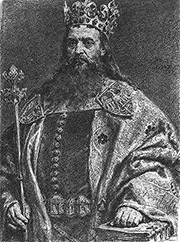
Another significant event, in addition to the baptism of the Lithuanian prince, was the visit of the King of Poland Casimir III - "in 1365, King Casimir of Poland arrived in Marienburg of his own free will, without an invitation" (SRP 6, 64). Most likely, the king's visit to the capital of the Order's Prussia took place in October (Szweda, 2011). The Master generously received the king as a distinguished guest. For three days, the king, accompanied by the Master's chamberlain, got acquainted with the castle, its rooms and buildings. Before leaving, King Casimir told Master von Kniproda that he was being incited to war, stating that the Order was not ready for it, but the king was convinced that he was being deceived and that he did not want to fight and would not allow Poland to fight the Order (SRP 2, 555).
At the end of the year, Duke Wilhelm II of Jülich arrived in Prussia with a large retinue to take part in another raid. However, the campaign itself took place the following year, 1366 (SRP 2, 556).
1365, although rich in events, is, in general, an ordinary year from the middle of the 14th century, showing how Prussian-Lithuanian relations proceeded. What happened next? Five years later, almost near Königsberg, a major battle took place between the forces of the Order and Lithuania - the Battle of Rudau. Then there was the unratified Treaty of Dubysa and Vitovt's tossing between the Order and Poland. After that, there was the Polish-Lithuanian Union of Krewo and the subsequent baptism of Lithuania. And then the Great War, the Battle of Grunwald and the First Peace of Thorn. All these are links in one chain and 1365 is only a small fragment of it.
Sources and literature:
National Library of France . Department of Manuscripts.
Scriptores Rerum Prussicarum . The social changes of the Pre-Russian Empire to the bottom of the military order. Erster Band. Hrsg. Theodor Hirsch, Max Töppen, Ernst Strehlke. Leipzig: Verlag von S. Hirzel, 1861.
Scriptores Rerum Prussicarum . The social changes of the Pre-Russian Empire to the bottom of the military order. Zweiter Band. Hrsg. Theodor Hirsch, Max Töppen, Ernst Strehlke. Frankfurt am Main: Minerva, 1965.
Scriptores Rerum Prussicarum. The social changes of the Pre-Russian Empire to the bottom of the military order . Dritter Band. Hrsg. Theodor Hirsch, Max Töppen, Ernst Strehlke. Leipzig: S. Hirzel Publishing House, 1866.
Scriptores Rerum Prussicarum. The social changes of the Pre-Russian Empire to the bottom of the military order . Sechster Band. Hrsg. Theodor Hirsch, Max Töppen, Ernst Strehlke. Frankfurt am Main: Minerva, 1968.
Kwiatkowski K., Zonenberg S. Wigand von Marburg. Now the crown of the pine tree. Toruń, 2017.
Szweda A. The history of the crown of Kazimierz Wielki in Malbork in 1365 // Historical records. Rocznik LXXVII, 2011.
Antonovich V. B. Essay on the history of the Grand Duchy of Lithuania until the death of Grand Duke Olgerd. - Kiev, 1995.
